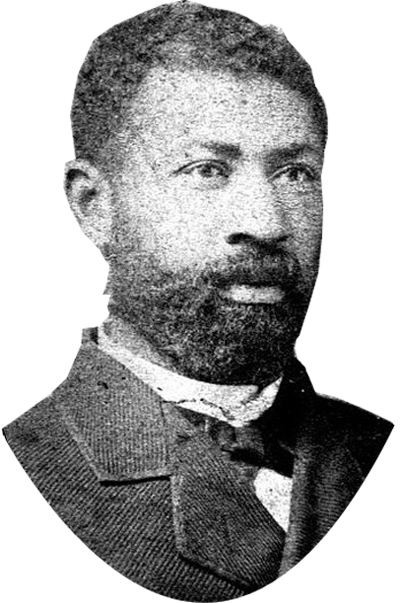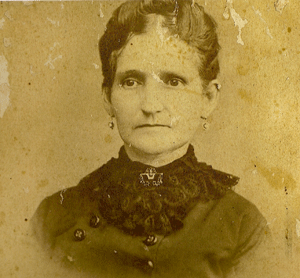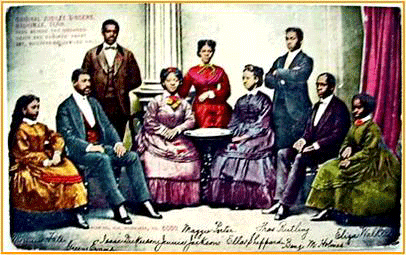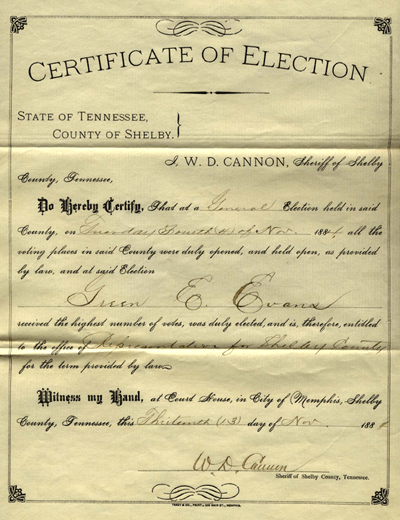 Slavery and the Civil War
Slavery and the Civil War
Greene E. Evans was born into slavery on the B. B. Degraffenreid plantation in northern Fayette County, Tennessee. When he was eight years old, his name appeared on an 1855 inventory of Degraffenreid’s property, along with the names of his mother, Adelia, and his siblings: Samuel (13), John (10), Martha (6), and Amanda (5). [The inventory called him “Green,” but in adulthood he typically signed his name as “Greene,” with a final “e.”]
Evans later told an interviewer that his father was the slave of “the richest man in Fayette County,” who owned “over 50 slaves.” The slave schedule of the 1850 U.S. Census named Baker Boswell Degraffenreid* as the owner of 74 slaves; in fact, before he gave slaves as gifts to some of his children in the 1840s, he owned more than 100. Although Alfred Evans’s wife and children lived on the Degraffenreid property, it is likely that Alfred himself was the slave of neighbors – probably Degraffenreid’s son-in-law Elijah L. Evans.
The story of Greene Evans’s experiences during the Civil War appears in several contemporary sources, so one can assume it was a tale he told many times. In their early teens when the war began, Greene and his brother John purportedly followed their master across several Southern states, dodging Yankees “from March 1862 almost to the end of the war.” Eventually, he said, they contrived a way to escape, lashing their trunk to a pole, which they carried between them on their shoulders, until, having hiked for 38 miles, they came around a corner and walked straight into a squad of Yankee soldiers. The two terrified boys were, to their surprise, welcomed by the soldiers. One of the officers made Greene his personal servant, taking him back to Indianapolis after the war and helping him find a job in the Bates Hotel, where the youngster, still in his teens, paid a large portion of his salary to a man who would teach him to read. (Note that the story never tells what happened to John, whose whereabouts continue to be a mystery.)

(Photo courtesy of the estate of Elvis Smith Jones)
So who was the “master” Greene and John Evans followed across the South until close to the end of the war – a fearful Henry Degraffenreid, running from the Yankees, or Solomon Green, eluding his creditors (and/or saving the boys from the court’s decree to return them to Henry)? It was unlikely to have been Henry, who, for all his cruelty, was no coward. He joined the 154th Tennessee Infantry, carried the rank of Captain, and marched off to defend the Confederacy, dying in the Battle of Stones River during the first days of 1863.o Therefore, we must look more closely at the Green family. It is likely that the gentle Sarah, who did return the field hands to the home farm, persuaded Henry to let her keep the two Evans boys as household servants – she may have realized that these bright, inquisitive youngsters would be sure to arouse Henry’s violent temper. According to a post-bellum petition filed by a creditor hoping to recover some money owed to him by Solomon Green’s estate, the Green family, with a few slaves, had moved from Memphis to Mississippi “in 1861 or 1862” (probably about March 1862, shortly before Memphis fell to Union forces). Dr. Solomon Green, who had actually joined the Confederate Army himself, died in Mississippi, intestate, sometime in 1863. He may have taken the two boys with him to the war as his body servants, and his death left them far from home. Thus, probably that very year, whether by design or accident, the boys ended up on their own, leaving them eventually to encounter the protective Union officer in Selma and to find themselves unexpectedly free.
Return to Memphis and education
Greene Evans seems to have altered a few of the details of this story in his frequent re-tellings – either to protect the Green family or simply to embroider his own legend. Whatever the truth may be, by 1866 he had returned to Memphis, where he worked during the day as a porter at a railroad depot and took classes at Tade’s AcademyΔ at night. After contracting smallpox and enduring a lengthy period of recovery, he quit work in order to attend school full-time. In 1868 he entered Fisk University in Nashville, paying his way by working as a groundskeeper on the Fisk campus, hauling gravel, laying sod, and performing other strenuous tasks. During the summers he returned to an area of West Tennessee near the Mississippi border, where he taught school in a primitive schoolhouse he had built himself. Most of the timbers he cut and dragged from the nearby woods or, at least once, “borrowed” from a neighbor who had been unwilling to sell it to him. He frequently joked that his schoolhouse “did not lack for ventilation, for a bird could fly through anywhere!”
His first appearance by name in federal census records was among a group of Fisk University residents in 1870. This particular census sheet reveals a great deal about African American education during the first years after the Civil War. Except for S. Stephenson (a white teacher, 35, born in Ohio) and M. Duckett (a chambermaid, 35, black, born in Mississippi), everyone else on the page was identified simply as “Scholar.” Although some of the students listed on this page were in their 20s, a surprising number were much younger, many 12 to 16 years old. About one-third were described as “black”; the rest (including Evans) were dubbed “mulatto.” Eight were girls, all quite young (12, 15, 17, and 18). Of the 29 students listed on the page, 17 came from Tennessee, eight from Mississippi, and one each from South Carolina, Kentucky, Virginia, and Alabama. African Americans were starved for education after emancipation, and most black colleges had a preparatory department, where students could learn the basics of reading, writing, math, history, and geography in order to be prepared to take college-level courses.
Early in his college career, Evans was selected as one of the original Fisk Jubilee Singers. He traveled with the group on their first American concert tour in 1871-1872 to raise money for the university. Described by one writer as “sober, industrious, and politically-minded” (Anderson 36) and by another as “decorous, fastidious, and enterprising” (Ward, p. 81), he sang bass with the group. He and the other three men in the Singers were all members of Fisk’s Union Literary Society, as Andrew Ward described them,

Tinted postcard of the first Fisk Jubilee Singers, 1871. The names of the singers are written at the bottom of the photo. Greene Evans is seated second from the left, wearing a blue suit.
(Postcard image courtesy of C. Michael Norton)
Freedman’s Bank records between the years 1869 and1874 reveal additional information about Evans and his family. At the time of his 1869 Memphis application he was living with his parents, “Alfred and Ardillo” [Adelia], at 352 Court Street extension. He listed his occupation as “teacher.” This was one of the rare documents that he signed as “Green” instead of “Greene.” In 1872, while still a student at Fisk University, the 23-year-old Evans opened an account at the Nashville bank. He named his siblings and noted that his mother was no longer living. In 1873 he opened an account in Memphis for his father, who was described as 51 years old with a “light” complexion. The application named “Green,” along with his brothers John and Samuel, sisters Mattie [Martha] and Amanda, and three sisters not listed on the Degraffenreid inventory: Lauretta, Valley, and Eliza. A note at the bottom of the page instructed, “Subject also to son’s orders; see signature below,” and was signed by Greene Evans.
By 1874, when Greene Evans listed his residence as “on the river,” he had graduated from Fisk and was back in Memphis working as deputy wharf-master, an important political post he would hold from 1874-1876. Over the next few years he also served as a city councilman (1877-1880), census enumerator (1880), and mail agent for the Robert E. Lee steamship line (1881-1882). Ironically, the council seat to which he was elected in 1877 had previously belonged to Confederate General Nathan Bedford Forrest, a former slave trader and the first Grand Wizard of the Ku Klux Klan.
Marriage, occupation, and election to the state legislature

Greene Evans would have presented this certificate to the House Clerk at the first legislative session he attended.
(TSLA)
The Memphis Board of Health Birth Register for 1882 (p. 260, file #5536) lists the birth of a daughter on December 4, 1882, to “Green Evans and ___ Evans,” at 25 Allen Ave., Ward 5. Although many of the infants were named in the register, the name of the Evanses’ daughter was not recorded. By the time of the 1900 census, the daughter had left the household, perhaps to marry or to attend college; no indication of her name has yet surfaced.
By 1884 Evans was running a coal and wood yard on DeSoto Avenue, often running quarter-page ads in the Memphis city directory. He and William A. Feilds, the two black Memphians elected as state representatives to the 44th General Assembly in 1884, became the targets of a scornful sketch in the Memphis Daily Appeal, titled “Who They Are – Sketches of the Recently Elected Senators and Representatives from This County and District.” Feilds fared slightly better than Evans, whom the writer characterized as an arrogant dandy:
The Cleveland Gazette was somewhat kinder to Evans: “The Legislature of Tennessee has among its members three colored members, Mr. McElwee, Mr. Fields, and Mr. Green E. Evans. These three gentlemen are all school teachers, and give evidence of aspirations to become lawmakers. They are young, ambitious and full of zeal, and if an opportunity is given may prove themselves equals and superiors of many Tennessean Senators before the adjournment of the present session.”
Service in the Tennessee General Assembly
In the legislature Evans was described as “polite and deferential to the House and to the Speaker” and “well liked.” He introduced five bills, the first two of which were intended to protect working men and women. HB 99 sought to limit the garnishment of a worker’s wages to his current, not future, wages. The second bill, HB 156, calling for apportionment of roadwork “among all able-bodied men” was an effort to amend the public road law to ensure the fair employment of African American workers. HB 447 was Evans’s attempt to repeal Chapter 130 of the Acts of 1875 (one or another of the black legislators endeavored unsuccessfully to pass such a bill in nearly every session). HB 514, in support of a request by the governor, was an effort to provide for an assistant superintendent of public instruction to oversee the education of black students. (Leon Howard had carried this bill unsuccessfully during the previous legislative session, along with legislation to repeal Chapter 130.) Evans’s fifth piece of legislation, HJR 108, was a resolution urging a particular cabinet appointment. Greene Evans’s much praised oratorical skills seem to have failed him in the legislature, for none of his bills was successful. Of the four African Americans in the House that term, only Samuel McElwee would see any of his bills pass into law.
Evans was in attendance at the 1885 World’s Industrial and Cotton Centennial Exposition in New Orleans, representing the General Assembly as Commissioner from Tennessee during the entire month of May. At the end of the month, other members of the Colored Department of the Exposition sponsored a farewell banquet in his honor.
Later years
In February 1889 Evans represented Tennessee at “an important conference of colored men” in Indianapolis. The dignitaries present issued a statement to newly-elected President Benjamin Harrison in support of appointing cabinet members who would support the 15th Amendment and protect black voters. In May Evans was appointed transfer mail clerk in Memphis. In June 1891 the social and entertainment column of the Tennessee News reported that “The debate Friday night between J. Bradford and G. E. Evans, and W. Ammons and I. F. Norris on whether marriage should be abolished, was decided in favor of the affirmative by the three judges.” It is interesting to note that both Evans and Norris moved out of Tennessee within the next year or so.
Sometime after June 1891, Greene Evans moved his wife Anna and their ten-year-old daughter to Chicago, Illinois. The 1900 city directory listed him as a coal dealer, living at 2917 Wentworth Avenue. Greene and Anna had been married for 25 years by that time. The 1910 census shows their ages to be 52 and 47. They were renting a house a few blocks farther north, at 3212 La Salle Street – both these streets today lie beneath the Dan Ryan Expressway. The Evanses said that they had been married 27 years and that their only child was still living.
Greene Evans died in Chicago on October 1, 1914. His death certificate listed his age as 64, but he was probably closer to 66. He was buried three days later in Chicago’s Lincoln Cemetery, an African American cemetery opened at the request of a group of black funeral directors in 1911.
____________________
*The B. B. Degraffenreid family was at the heart of a tragic event in Maury County in March 1835. A tornado still referred to as the “Degraffenreid storm” hit the western part of the county, killing Degraffenreid’s second wife, Sarah, and four of his sons, as well as several people on a neighboring farm.
o”It was reported in August 1865 that Captain DE GRAFF, a Confederate killed a Murfreesboro, Tenn. during the war, left HARRY DE GRAFF (colored) and twenty other blacks on his place six miles from Somerville, Tenn., on the Brownsville road, when he went into service and these freedmen had remained there, raised a crop and were to be allowed to remain on the place for the time being as the government had taken over the "DE GRAFF" property. Later that month, Mr. SPRINGFIELD, legal administrator of the estate of HENRY DE GRAFFENREID, Fayette County, was allowed to ‘gin, bale and bring’ in Memphis the cotton raised on this man's property (650 acres), to await his portion of the money resulting from the sale of the crop. The blacks who had labored on the place were to be awarded their share of the sale of the cotton crop, too.” (Smith, p. 82)
ΔThe Reverend Ewing Tade, a Congregational minister from Iowa, was known for reaching out to emancipated slaves from his pulpit. He set up preparatory schools in Chicago and Memphis to help African Americans prepare themselves for life in a new, more competitive society.
Permission to use the song "In Bright Mansions" from the Fisk Jubilee Singers' 2004 Grammy-nominated album of the same name, has been granted by Curb Records, Inc., Nashville, TN. KBL 11/06/2012
Based in large part on the research of John W. Marshall, Memphis, TN, author of The Early History of Mason (1985) and Mason: A Glimpse into the Past (1991).
Sources:
Anderson, Toni P. “Tell Them We Are Singing for Jesus,” The Original Fisk Jubilee Singers and Christian Reconstruction, 1871-1878. Macon, GA: Mercer University Press, 2010.
Cartwright, Joseph H. The Triumph of Jim Crow: Tennessee Race Relations in the 1880s. Knoxville: University of Tennessee Press, 1976.
Cleveland Gazette, January 24, 1885; April 4, 1885.
“Colored Conference,” Columbus Daily Enquirer, February 15, 1889.
“A Curious Case in Tennessee,” New York Times, July 8, 1866, from Memphis Avalanche, June 21, 1866.
“Disfranchising Laws.” Tennessee Encyclopedia of History and Culture. Nashville: Rutledge Hill Press, 1998.
"Fisk Jubilee Singers." http://fiskjubileesingers.org/our_history.html
Freedman’s Bank records, Ancestry.com.
Freeman, May 4, 1889; June 13, 1891.
Leavenworth Advocate, May 11, 1889.
Maury County, TN 1860 Federal Census: http://us-census.org/pub/usgenweb/census/xtn/maury/1860/notes.txt
McBride, Robert M., and Dan M. Robinson. Biographical Directory, Tennessee General Assembly, Volume II (1861-1901). Nashville:
Tennessee State Library and Archives, and Tennessee Historical Commission, 1979.
Memphis City Directories: Boyle-Chapman, 1874, 1876; Sholes, 1877-1885; Weatherbe, 1883; Dow, 1885-1892; Polk, 1891-1892.
Memphis Daily Appeal, November 13, 1884.
Pike, Gustavus D. The Jubilee Singers and Their Campaign for Twenty Thousand Dollars. New York: Lee, Shepard & Dillingham, 1873.
“Political Pointers,” Dallas Morning News, February 15, 1889.
Scott, Mingo Jr. The Negro in Tennessee Politics and Governmental Affairs, 1865-1965: “The Hundred Years Story.” Nashville: Rich Printing Co.,
1964.
“She Was Not His Aunty,” Huntsville Gazette, September 28, 1889.
Smith, Jonathan Kennon Thompson Smith. Genealogical and Historical Gleanings from the Freedmen’s Bureau Records, West Tennessee, 2003.
“Miscellanea,” p. 82. http://www.tngenweb.org/records/madison/misc/freedmen/fbwtn-06.htm
“Speed the Parting Guest,” Times-Picayune, May 23, 1885.
Tennessee General Assembly. Journal of the House of Representatives of the State of Tennessee. Nashville: Tavel and Howell, 1881, 1883.
Ward, Andrew. Dark Midnight When I Rise: The Story of the Jubilee Singers Who Introduced The World to the Music of Black America. New York:
Farrar, Straus and Giroux, 2000.
------- “Evans, Greene (1848-1914).” BlackPast.org: Remembered and Reclaimed. http://blackpast.org/?q=aah/evans-greene-1848-1914
Whitson, Mrs. L. D. Personal Sketches of Members of the Forty-Fourth General Assembly of Tennessee. Nashville: Southern Methodist Publishing
House, 1885.
“Who They Are – Sketches of the Recently Elected Senators and Representatives from this County and District,” Memphis Daily Appeal,
November 13, 1884.
Work, Monroe N. “Some Negro Members of the Tennessee Legislature During Reconstruction Period and After.” Journal of Negro History, Vol. V,
January 1920, 114-115.
“World’s Exposition: A Busy Day at the Grounds—Celebration by the Temperance Women. Continuance of the Session of the Immigration
Convention. General Notes and Items—TheTennesseans.” Times-Picayune, March 14, 1885.

